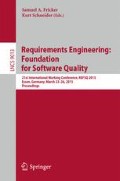Abstract
[Context and motivation] Validating natural language requirements is an important but difficult task. Although there are techniques available for validating formalized requirements, the gap between natural language requirements and formalism is huge. [Question/ problem] As part of a larger piece of work on temporal requirements consistency checking, we developed a front end to semi-automatically translate natural language requirements into an formal language called Temporal Action Language or \( TeAL \). This work is based on an underlying assumption that human analysts can assist us in filling in the missing pieces as we translate natural language temporal requirements to \( TeAL \).[Principal ideas/results] We performed a study to validate this assumption. We found that using the statements generated by our front-end tool appears to be more effective and efficient than a manual process. [Contribution] We present the design of our front-end and a study that measures the performance of human analysts in formalizing requirements with the help of an automated tool.
Access this chapter
Tax calculation will be finalised at checkout
Purchases are for personal use only
Preview
Unable to display preview. Download preview PDF.
References
CM-1 Dataset PROMISE Website. http://promisedata.org/promised/trunk/promisedata.org/data/cm1-maintain/cm1-maintain.txt, (accessed: April 18, 2013)
Regional real-time transit information system system requirements version 3.0 (2012). http://www.mtc.ca.gov/planning/tcip/Real-Time_TransitSystemRequirements_v3.0.pdf, (accessed: April 18, 2013)
Baldridge, J.: The opennlp project. http://opennlp.apache.org/index.html (accessed February 2, 2012) (2005)
Baral, C., Gelfond, M.: Reasoning agents in dynamic domains. In: Logic-Based Artificial Intelligence, pp. 257–279. Springer (2000)
Cimatti, A., Giunchiglia, E., Pistore, M., Roveri, M., Sebastiani, R., Tacchella, A.: Integrating BDD-based and SAT-based symbolic model checking. In: Armando, A. (ed.) FroCos 2002. LNCS (LNAI), vol. 2309, pp. 49–56. Springer, Heidelberg (2002)
Cleland-Huang, J., Settimi, R., Zou, X., Solc, P.: The detection and classification of non-functional requirements with application to early aspects. In: 14th IEEE International Conference on Requirements Engineering, pp. 39–48. IEEE (2006)
De Marneffe, M.C., MacCartney, B., Manning, C.D., et al.: Generating typed dependency parses from phrase structure parses. Proceedings of LREC 6, 449–454 (2006)
Deeptimahanti, D.K., Babar, M.A.: An automated tool for generating uml models from natural language requirements. In: 24th IEEE/ACM International Conference on Automated Software Engineering, ASE 2009, pp. 680–682. IEEE (2009)
Dwyer, M.B., Avrunin, G.S., Corbett, J.C.: Patterns in property specifications for finite-state verification. In: Proceedings of the 1999 International Conference on Software Engineering, pp. 411–420. IEEE (1999)
Fliedl, G., Kop, C., Mayr, H.C., Winkler, C., Weber, G., Salbrechter, A.: Semantic tagging and chunk-parsing in dynamic modeling. In: Meziane, F., Métais, E. (eds.) NLDB 2004. LNCS, vol. 3136, pp. 421–426. Springer, Heidelberg (2004)
Gildea, D., Jurafsky, D.: Automatic labeling of semantic roles. Computational Linguistics 28(3), 245–288 (2002)
Holzmann, G.J.: The model checker spin. IEEE Transactions on Software Engineering 23(5), 279–295 (1997)
Huth, M., Ryan, M.: Logic in Computer Science: Modelling and reasoning about systems. Cambridge University Press (2004)
Klein, D., Manning, C.D.: Accurate unlexicalized parsing. In: Proceedings of the 41st Annual Meeting on Association for Computational Linguistics, vol. 1. pp. 423–430. Association for Computational Linguistics (2003)
Konrad, S., Cheng, B.H.: Facilitating the construction of specification pattern-based properties. In: Proceedings of the 13th IEEE International Conference on Requirements Engineering, pp. 329–338. IEEE (2005)
Konrad, S., Cheng, B.H.: Real-time specification patterns. In: Proceedings of the 27th International Conference on Software Engineering. pp. 372–381. ACM (2005)
Larsen, K.G., Pettersson, P., Yi, W.: Uppaal in a nutshell. International Journal on Software Tools for Technology Transfer (STTT) 1(1), 134–152 (1997)
Levy, R., Andrew, G.: Tregex and tsurgeon: Tools for querying and manipulating tree data structures. In: Proceedings of the Fifth International Conference on Language Resources And Evaluation. pp. 2231–2234. Citeseer (2006)
Li, W., Brown, D., Hayes, J.H., Truszczynski, M.: Answer-set programming in requirements engineering. In: Salinesi, C., van de Weerd, I. (eds.) REFSQ 2014. LNCS, vol. 8396, pp. 168–183. Springer, Heidelberg (2014)
Li, W., Hayes, J.H., Truszczyński, M.: Temporal Action Language (TAL): A controlled language for consistency checking of natural language temporal requirements. In: Goodloe, A.E., Person, S. (eds.) NFM 2012. LNCS, vol. 7226, pp. 162–167. Springer, Heidelberg (2012)
Marcus, M.P., Marcinkiewicz, M.A., Santorini, B.: Building a large annotated corpus of english: The penn treebank. Computational Linguistics 19(2), 313–330 (1993)
Marek, V.W., Truszczyński, M.: Stable models and an alternative logic programming paradigm. In: The Logic Programming Paradigm, pp. 375–398. Springer (1999)
Mondragon, O.A., Gates, A.Q.: Supporting elicitation and specification of software properties through patterns and composite propositions. International Journal of Software Engineering and Knowledge Engineering 14(01), 21–41 (2004)
Niemelä, I.: Logic programs with stable model semantics as a constraint programming paradigm. Annals of Mathematics and Artificial Intelligence 25(3–4), 241–273 (1999)
Nikora, A.P., Balcom, G.: Automated identification of ltl patterns in natural language requirements. In: 20th International Symposium onSoftware Reliability Engineering, ISSRE 2009, pp. 185–194. IEEE (2009)
Smith, R.L., Avrunin, G.S., Clarke, L.A., Osterweil, L.J.: Propel: An approach supporting property elucidation. In: Proceedings of the 24th International Conference on Software Engineering, pp. 11–21. ACM (2002)
Snover, M., Dorr, B., Schwartz, R., Micciulla, L., Makhoul, J.: A study of translation edit rate with targeted human annotation. In: Proceedings of Association for Machine Translation in the Americas, pp. 223–231 (2006)
Spyns, P.: Natural language processing. Methods of Information in Medicine 35(4), 285–301 (1996)
Tichy, W.F., Padberg, F.: Empirical methods in software engineering research. In: 29th International Conference on Software Engineering-Companion, ICSE 2007 Companion, pp. 163–164. IEEE (2007)
Weston, N., Chitchyan, R., Rashid, A.: A framework for constructing semantically composable feature models from natural language requirements. In: Proceedings of the 13th International Software Product Line Conference, pp. 211–220. Carnegie Mellon University (2009)
Author information
Authors and Affiliations
Corresponding author
Editor information
Editors and Affiliations
Rights and permissions
Copyright information
© 2015 Springer International Publishing Switzerland
About this paper
Cite this paper
Li, W., Hayes, J.H., Truszczyński, M. (2015). Towards More Efficient Requirements Formalization: A Study. In: Fricker, S., Schneider, K. (eds) Requirements Engineering: Foundation for Software Quality. REFSQ 2015. Lecture Notes in Computer Science(), vol 9013. Springer, Cham. https://doi.org/10.1007/978-3-319-16101-3_12
Download citation
DOI: https://doi.org/10.1007/978-3-319-16101-3_12
Published:
Publisher Name: Springer, Cham
Print ISBN: 978-3-319-16100-6
Online ISBN: 978-3-319-16101-3
eBook Packages: Computer ScienceComputer Science (R0)

